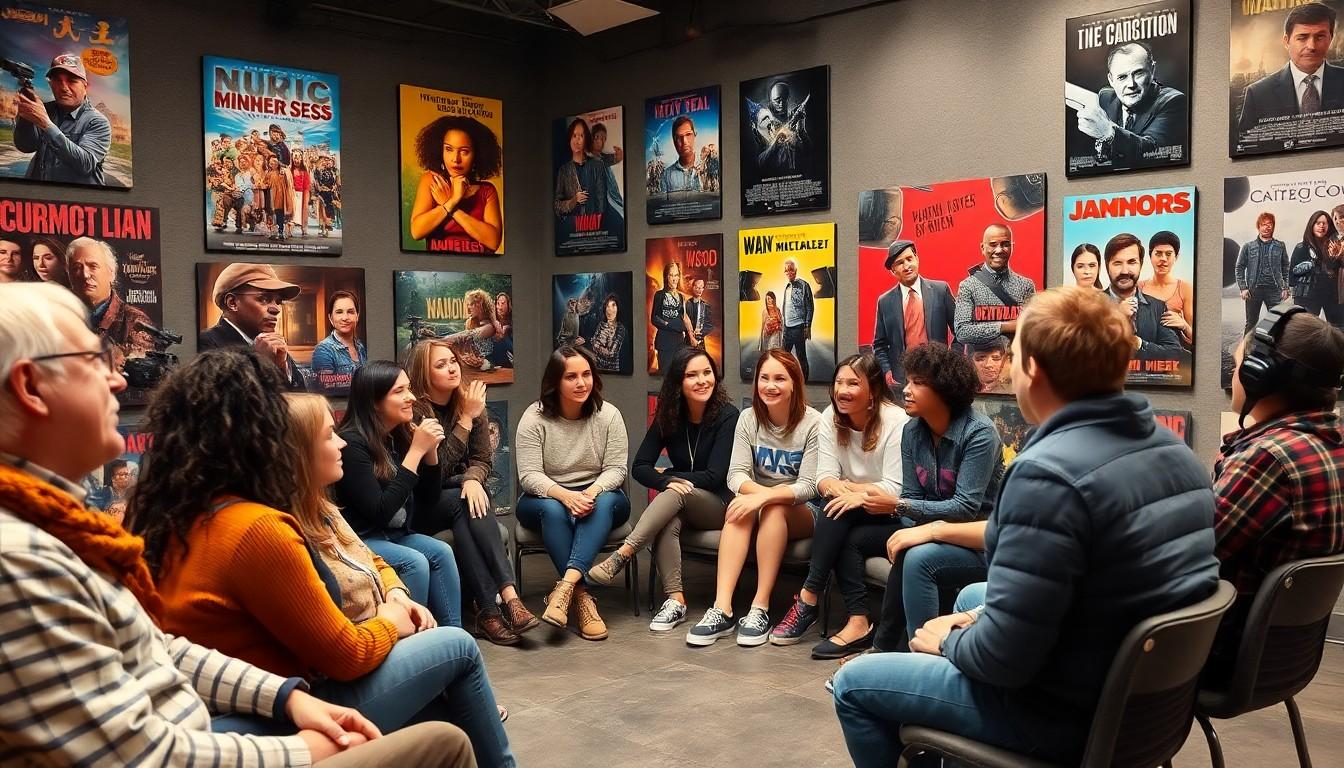Film isn’t just a source of entertainment; it’s a powerful lens through which culture and gender come alive. Ever noticed how a single movie can spark debates, inspire movements, or even change perspectives? By exploring the intersection of culture and gender in film, one can uncover layers of meaning that go beyond the screen.
Overview of Exploring Culture and Gender Through Film
Film serves as a powerful lens for examining cultural and gender dynamics. It offers insights into societal norms, values, and identities. Directors and writers often reflect their perspectives about culture and gender through storytelling. Through diverse narratives, films challenge traditional roles and provoke thought.
Classifications within films can highlight the differences in experiences based on gender and cultural backgrounds. These distinctions may reveal underlying biases or stereotypes. By analyzing characters and plotlines, viewers gain a deeper understanding of how culture shapes gender identity. Different genres tackle various aspects of culture and gender, ranging from drama to documentary.
Significant films often spark conversations and debate on cultural representation. By portraying complex characters, filmmakers can challenge viewers’ preconceived notions. Specific examples include films that highlight marginalized voices or explore gender fluidity. Those examples illuminate the broad spectrum of human experience and identity.
Film analysis encourages critical thinking about societal standards. Engaging with film can propel audiences to advocate for change. Unearthing themes of resilience and empowerment often resonates strongly with viewers. Audiences find themselves at times feeling personally connected to the stories on screen.
Moreover, festivals and screenings frequently focus on films that explore these themes. Discussions at these events provide platforms for shared experiences and perspectives. The cultural significance of film extends beyond entertainment; it serves as a medium for education and activism. During film discussions, participants often discover new angles on familiar societal issues.
Through exploration of culture and gender in film, individuals can recognize and appreciate diversity in perspectives. Such recognition promotes understanding and encourages empathy. Each film contributes uniquely to the ongoing dialogue about culture and gender, reinforcing the importance of representation in contemporary society.
The Importance of Film in Cultural Representation

Film plays a crucial role in shaping cultural narratives and gender dynamics. As a visual medium, it captures the complexities of identity and societal norms, prompting discussions that resonate with audiences.
Historical Context
Throughout history, film has documented and influenced cultural shifts. Early cinema often portrayed women and diverse groups through stereotypes. As social movements emerged, filmmakers began challenging these representations. Significant films from the 1960s and 1970s addressed pressing issues like civil rights, feminism, and global politics. Directors like Spike Lee and Agnes Varda pushed boundaries, offering nuanced portrayals of marginalized communities. Viewing these films reveals the evolution of cultural representation, reflecting changes in societal attitudes over time.
Contemporary Relevance
In today’s landscape, films continue to address cultural and gender issues. Recent works spotlight underrepresented voices, promoting inclusivity within the industry. Streaming platforms diversify content options, presenting narratives that capture various cultural experiences. Movies like “Moonlight” and “Parasite” exemplify this shift, illustrating how storytelling can challenge norms and stereotypes. The ongoing dialogue around representation influences both audience perceptions and industry practices. Engaging with contemporary films fosters a deeper understanding of the intricacies of identity in a global context.
Gender Perspectives in Film Analysis
Film analysis offers a valuable framework for understanding gender dynamics. This exploration encompasses various theories and representations that shape cultural narratives.
Feminist Film Theory
Feminist film theory examines the portrayal of women in cinema. It critiques male-centric narratives and highlights female experiences. Key figures, such as Laura Mulvey, argue that traditional films often display women as objects for male gaze. By analyzing character development and story arcs, feminist scholars uncover how films reinforce or challenge gender stereotypes. This analysis emphasizes the importance of women’s agency and representation in shaping societal views. Movies like “Thelma & Louise” and “Frida” illustrate the complexity of female identities, promoting a deeper understanding of gender equality and societal roles.
Representation of Masculinity
Representation of masculinity in film reflects societal expectations and norms. Films often depict masculinity through power dynamics, aggression, and emotional restraint. Many male characters are portrayed as heroes while others depict vulnerabilities, showcasing diverse interpretations. Analyzing films like “Fight Club” and “Moonlight” reveals how masculinity can be both rigid and fluid. These narratives challenge traditional definitions and encourage discussions about men’s emotional lives. By examining these portrayals, audiences gain insights into how media influences perceptions of male identity and behavior.
Cultural Narratives and Their Impact
Film serves as a powerful tool for exploring cultural narratives and their influence on gender identity. Through the lens of cinema, audiences can engage with diverse experiences, fostering critical discussions.
Case Studies of Notable Films
“Moonlight” offers a profound examination of race and sexuality, portraying a young Black man’s journey to self-discovery. This film challenges stereotypes while highlighting the importance of embracing one’s identity. “Parasite” critiques class disparity through a gripping narrative, revealing how social hierarchies shape human interactions. Both films emphasize the significance of cultural representation in storytelling. Directors intentionally craft complex characters, contributing to a richer understanding of societal norms.
Understanding Intersectionality
Intersectionality in film analysis reveals how overlapping identities impact experiences. This concept highlights that gender, race, and class don’t exist in isolation. Films like “The Help” demonstrate how marginalized voices shape narratives, addressing both gender and racial dynamics. Understanding intersectionality encourages viewers to consider multiple aspects of identity, fostering empathy and awareness. By engaging with films that reflect diverse experiences, audiences can better appreciate the complexity of individual stories and their collective significance.
Accessing Resources: Exploring Culture and Gender Through Film PDF Free Download
Accessing resources in PDF format enables convenient and efficient engagement with the topic of culture and gender in film. PDFs remain universally compatible across devices, ensuring easy reading on computers and mobile gadgets. They retain original formatting, making it simple to navigate through complex analyses, including references and images. Searchable text features allow readers to quickly locate specific sections, enhancing the learning experience. Furthermore, shared access enables collaborative discussions among peers, fostering deeper understanding and exploration of critical themes.
Benefits of PDF Format
PDF format caters to diverse reading preferences and study styles. It provides high-quality images and graphics, which enrich visual learning. Offline access permits uninterrupted reading, ideal for those in areas with limited internet connectivity. Simultaneously, annotations and highlights help distill important concepts, making comprehension easier. Students and educators often appreciate the ability to share concise insights with others. Searchability within documents promotes efficient research, allowing users to extract valuable information rapidly.
Locations for Downloading
Numerous online platforms host PDFs exploring culture and gender through film. Academic databases like JSTOR and Google Scholar provide access to peer-reviewed articles and research papers. University libraries often carry downloadable resources that focus on film studies. Websites specializing in educational materials may also offer free downloads. Popular community sites, such as ResearchGate, enable authors to share their work with broader audiences. Accessing institutional repositories can yield valuable thesis and dissertation materials related to the subject.
Conclusion
Exploring culture and gender through film reveals the intricate ways these themes intertwine within society. Films serve as a mirror reflecting cultural dynamics while challenging established gender norms. By analyzing diverse narratives, audiences gain insights into the complexities of identity and representation.
The accessibility of resources like PDFs enhances the learning experience, allowing for deeper engagement with these critical topics. As filmmakers continue to push boundaries and highlight underrepresented voices, the conversation around culture and gender will undoubtedly evolve. Embracing this dialogue fosters empathy and understanding, encouraging viewers to advocate for change and inclusivity in the cinematic landscape.

